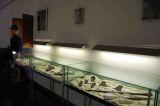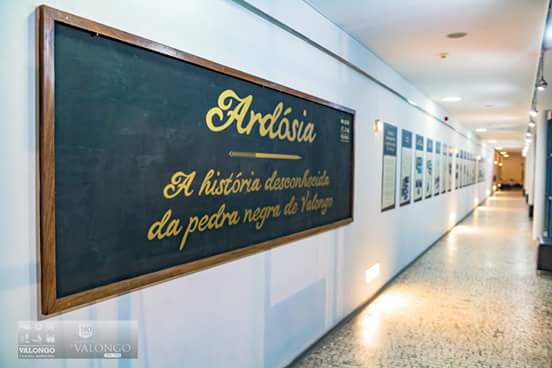The Slate Museum, Campo - Valongo
The Museu da Lousa is composed of 3 houses, built with the traditional technique, such as the exterior wall. The first house is intended for carrying out slate workshops. The second house evokes a miner’s house, with a kitchen area, a nocturnal rest area and the workshop, where women and children made penas de lousa (slate pencils) during the evening to complement the small salaries earned at the mine. In the other 2 buildings are displayed the estate and documentation related to the slate, from its extraction to the several types of transformation. Of noteis the set of machines used for making school slates used by generations of students spread all over the world and the exhibition of works in slate created by students of Vallis Longus schools in the discipline of Arts in Slate
CHARACTERISTICS
City: Campo - Valongo
Postal Code: 4440 - 191
Telephone: 22 242 64 90
Email: dctj@cm-valongo.pt
Website: http://www.cm-valongo.pt
monday, tuesday, wednesday, thursday, friday
From 00:00:00 to -.
From 17:30:00 to -.
Weekend and Holidays Schedule:
From 00:00:00 to 00:00:00.
From 00:00:00 to 00:00:00.
Exceptions:
For groups the opening of the Slate Museum is done by appointment, so it is necessary a prior contact with the Museum of Valongo Municipal by telephone: 91 103 46 87. At weekends and holidays the visit is made only upon formal request superiorly authorized.
Paid Entry:
0€
Discount Policy:
Free entry
Specific Conditions:
Handicap accessible
Method:
On foot
Difficulty Level:
Low
Group Visits:
Yes
Minimum Number of Person per group:
10
Maximum Number of Person per group:
25
Observations:
At weekends and holidays the visit for groups is made only upon formal request superiorly authorized.
Guided Tours:
Yes
Observations:
The opening of the Slate Museum is done by appointment, so it is necessary a prior contact with the Museum of Valongo Municipal by telephone: 91 103 46 87. The tours can be complemented with a visit to the Empresa das Lousas, where you can observe the slate extraction process in an opencast mine and watch the slate transformation process into various products. Those interested should schedule a visit directly with the Empresa das Lousas by calling the following phone number 22 415 74 00.
Open to the public since October 2001, this space was conceived to provide knowledge in regards to one of the most characteristic traditions of Valongo, the extraction and transformation of slate, as well as to promote the mining heritage of the municipality, making it a reference from among the neighbouring sites.
Activity Program:
It is possible to schedule guided tours and workshops in advance, and thus accompany this visit with a trip to the Empresa de Lousas de Valongo [Valongo Slate Company], where the open-sky extraction and the transformation of slate into many different objects can be seen. These objects include everything from simple tiles to pool tables, made with human expertise or by using large computer controlled machines. Interested should schedule a direct visit with the company through n.º 22 415 74 00.
Study and Research Unit:
Study, appreciation and promotion of geology and mining heritage as this relates to slate.
Audiovisual and Multimedia Resources:
In addition you can watch the documentary "The Unknown History of the Black Stone of Valongo ..." available through the link: https://www.youtube.com/watch?v=NAWUQPcTphQ.
Volunteering Programs:
-
Painting on Slate, Graffiti on Slate, Puppet Assembly of miners and their families
Target Audience:
Pre-school, students and adults
Activity Cost:
0€
Weekly Schedule:
monday, tuesday, wednesday, thursday, friday
From 09:00:00 to 12:30:00.
From 14:00:00 to 17:30:00.
Weekend and Holidays Schedule:
From 00:00:00 to 00:00:00.
From 00:00:00 to 00:00:00.
Exceptions:
Educational services are carried out by appointment, so it is necessary a prior contact with the Museum of Valongo Municipal through the telephones: 91 103 46 87.
Observations:
Educational services are carried out by appointment, so it is necessary a prior contact with the Museum of Valongo Municipal through the telephones: 22 242 64 90, 91 103 46 87 and 91 103 49 71. During weekends and holidays only upon formal request authorized.
http://www.cm-valongo.pt/descobrir/alojamento
Where to Eat
http://www.cm-valongo.pt/descobrir/gastronomia-e-vinhos
Cultural Facilities
http://www.cm-valongo.pt/descobrir/o-que-visitar
Security Forces
http://www.min-saude.pt/Portal/servicos/prestadoresV2/?providerid=144
Security Forces
http://www.psp.pt/Pages/pesquisa_detalhe.aspx?menu=28submenu=18unidade=777
Táxi
Agency Name:
Joaquim Fernando de Jesus Moreira
Telephone Number:
22 422 59 49
Type of Transport:
Táxi
Agency Name:
Orlando Gentil de Sousa Moreira
Telephone Number:
91 978 37 50
Type of Transport:
T. Rodoviário
Agency Name:
Auto Viação Pacense, Lda
Telephone Number:
255860220
Type of Transport:
T. Rodoviário
Agency Name:
Empresa de Transportes Gondomarense
Telephone Number:
22 485 32 50
Type of Transport:
T. Rodoviário
Agency Name:
RESENDE - Actividades Turísticas, SA
Telephone Number:
22 939 90 60
Type of Transport:
T. Rodoviário
Agency Name:
Rodonorte
Telephone Number:
22 200 56 37
Type of Transport:
T. Rodoviário
Agency Name:
STCP - Sociedade de Transportes Colectivos do Porto
Telephone Number:
22 507 10 00
Type of Transport:
T. Rodoviário
Agency Name:
Valpibus
Telephone Number:
22 415 79 60
Parking for private vehicles:
Yes
Typical building of industrial architecture from the end of the 19th century, of British origin. Executed with slate blocks of various sizes which vividly contrast with the red doorways and windows. The two buildings where administrative services were performed were elevated and built on either side of the central body, where the blocks extracted from the mine were transformed.
gps: 41.17 -8.46982
distance: 3km
Igreja Matriz de Valongo [Main Church of Valongo]
The Church´s rectangular floor plan of only one nave is covered by a roof of two sides (slopes). A bell tower with a clock is installed on the right side. The exterior is covered with white tiles with blue, figurative ornamentation of religious motifs. The ceiling is painted, the altars are of gilded engravings and there are incomplete panels of blue and white, figurative tiles which represent biblical scenes. Although the current building dates to 1904, it includes constructive characteristics from the medieval period. Patron Saint: São Martinho.
gps: 41.18788 -8.50154
distance: 3km
Núcleo Museológico da Panificação [Bread Baking Museum Centre]
This location presents one of the most important industries of Valongo: bread making and biscuit manufacturing. It is installed in the Ferreira Bridge Mill and houses a set of instruments, photographs and diagrams which describe the bread making cycle, all the way from the preparation of the land up to the manufacturing of the bread and biscuits. The main grains, and their substitutes, are identified and the milling processes and the baking processes can be witnessed in their diverse phases.
gps: 41.18836 -8.45911
distance: 4km
Ferreira Bridge, Niches and the Toll House
Granite bridge of medieval origin. It has a flat deck that is set over 3 equally-sized pointed arches, which are separated by wedge-shaped breakwaters and stone guards. It was part of the ancient route between Porto and Amarante. It also has a Toll House and Niches. Its importance stems from the fact that in this location a battle between the Liberals and the Miguelists was waged on July 23, 1832.
gps: 41.18869 -8.45834
distance: 0km
Luriz Bridge
Granite bridge of Roman origin and medieval reconstruction. It has a pointed deck that rests on 3 unequal arches, two which are of perfect roundness and the central arch is gothic pointed. It has a wedge-shaped breakwater between the two largest arches and it has stone guards. There is a small stairway which provides access to the river bed. In accordance with popular tradition, it is known as the Bridge of Death, although the motive for this name is unknown. The route which passes over it stretches from Valongo to Penafiel.
gps: 41.18024 -8.45941
distance: 3km
Milhária Bridge
Bridge of typical iron architecture, with a metallic deck supported by four pillars. This set is continued on both sides by granite structures which outline rounded arches of unequal sizes, as these are adapted to the irregularities of the landscape. The construction dates back to the 1920´s
gps: 41.17324 -8.47456
distance: 0km
Chapel Nossa Senhora da Encarnação
Of great structural simplicity, rectangular, single nave and frontal narthex, covered with a two sided (slopes) roof, joined at the highest point by two granite crosses. It has a high choir and the ceiling is covered with wood painted in a single colour with a cross in the centre. It features a bell tower. The churchyard is tiled with slate and is surrounded by a wall with iron doors. It belonged to the nuns from the extinct convent of Ave-Maria in Porto and its origin dates back to the 16th century. It has undergone many remodelling works over the centuries
gps: 41.17709 -8.47007
distance: 3km
Chapel of São João Batista
Simple, rectangular floor plan, single nave, covered with a two-sided (slopes) roof, joined at the highest point by a cross. It possesses a small bell tower with a bell supported on the left side of the base of the roof. Its construction was undertaken by the will of the people in the 1950´s. On the facade is a niche containing an image of the patron saint.
gps: 41.18108 -8.47856
distance: 0km
Chapel of São João da Azenha
Unique chapel of neoclassic character from the 17th century. Its floor plan is longitudinal, possesses a single nave and a narrower apse. The facade is covered with recent industrialised tiles of a monochrome blue, which are repeated in the interior in a square format, associated with wood and white stucco. There are various gilded engravings. It has been the target of many restorations over time.
gps: 41.18205 -8.48085
distance: 1km
Situated in the Oporto Metropolitan Area, municipalities of Gondomar, Paredes and Valongo have a wide and relevant geological and mining heritage which manifests itself in terms of stratigraphy, paleontology, tectonics, geomorphology and mineral resources, with special emphasis on the fossil-bearing deposits, auriferous and coal mineralization’s, and the slate deposits from the Paleozoic Era.
Granite rock intrudes schist from the Metamorphic Complex of Foz do Douro, in the north. To the south are leucrocratic augen gneisses. Explanatory display panel.
The municipality of Paredes in partnership with the Department of Geosciences of FCUP have worked in the preservation and promotion of the the Gold Mines of Castromil. This work received an Honorable Mention in the Geoconservation Award, 20 ...
In Paredes, the Castromil and Banjas areas shows important vestiges of the auriferous exploitations of Romans times. This region belongs to the northwest Iberian Peninsula that has been considered one of the richest and most gold produced ...
Observation of augen gneiss and granite intruded schist or metasediments. Explanatory display panel.
Amphibolites which resulted from the metamorphous of basalt close to one billion years ago can be observed. Explanatory display panel.
Observation of igneous breccia outcroppings generated during the intrusion of a granite vein in the older rocks. Explanatory display panel.
The Foz do Douro Geological Trail Interpretive Centre opened on November 27, 2008 and provides a space for the realisation of activities to supplement field trips to the outdoor trail.
Created in 1989 , the Mining Museum of São Pedro da Cova has as its mission the enhancement , promotion and dissemination of geological and mining of São Pedro da Cova . Housed in the old Houses of Malta is acquired by the Parish of São Ped ...
Within FEUP’s (Faculty of Engineering of the University of Porto) Library and Information Services, the Museum Unity is responsible for the management of the museum collections of the Faculty. Based on a polynucleated museum layout model, t ...
The Museum of the Instituto Superior de Engenharia do Porto [Higher Institute of Engineering Museum in Oporto] was created in 1998. This location was created to satisfy a long standing desire to unite and explore a precious collection of sc ...
Outcroppings of biotite gneiss and leucocratic gneiss "mixed" with metasediments. Explanatory display panel.
The Stone Museum of Marco de Canaveses is more than what you see. The permanent exhibition is the first step of a project to extend the Museum to other places. In the future it will be a polynuclear museum. Larger, dynamic and innovative. ...

















